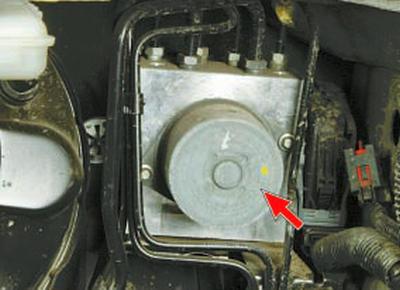WARNINGS: Attempts to tamper with the operation of the electronic brake control systems will result in their failure.
All maintenance and repair work on these systems should be carried out only at specialized service stations that have the necessary equipment and qualified personnel.
Electronic systems improve the handling and braking qualities of the car, but do not replace the driver, as they cannot prevent incidents due to careless driving on their own. Do not make gross mistakes in driving, relying on auxiliary systems.
The ABS system is used to regulate the pressure in the brake mechanisms of all wheels when braking in difficult road conditions, which prevents the wheels from blocking.
The ABS system provides the following benefits:
avoiding obstacles with a higher degree of safety, including during emergency braking;
- reduction of the braking distance during emergency braking while maintaining roadholding and controllability of the car, including when cornering.
The ABS system includes:

– hydroelectronic control unit (GEBU), which receives information about vehicle speed, direction of travel, and road conditions from wheel speed sensors. After the ignition is switched on, the ABS module supplies voltage to the sensors;
WARNING: If air enters the hydro-electronic unit, it cannot be pumped without special equipment. In this regard, to replace the unit, contact a service station.

- wheel speed sensors. The sensors use the Hall effect, they generate an output signal in the form of electrical impulses. The signal changes in proportion to the rotational speed of the encoder pulse ring built into the front hub bearing seal and directly into the rear hub. Wheel speed information is used to determine vehicle speed;
– a signal lamp of malfunction of antiblocking system of brakes (with yellow filter). The lamp lights up when the ignition is on for 3 s. When the starter is turned on, the lamp lights up constantly.
After starting the engine, it should go out immediately. In the event of a system failure, the lamp is permanently on.
WARNING: If the lamp lights up while driving, contact a car service, as braking in all cases will occur without the participation of the anti-lock braking system.
Based on the information received from the sensors, the GEBU determines the optimal wheel braking mode.
There are the following modes of operation of the anti-lock braking system:
– normal braking mode. During normal braking, the solenoid valve is de-energized, the inlet valve is open, the outlet valve is closed. When the brake pedal is pressed, pressurized brake fluid is supplied to the working cylinder through the solenoid valve and actuates the wheel brakes. When the brake pedal is released, the brake fluid returns to the brake master cylinder through the inlet and check valves;
– emergency braking mode. If during emergency braking the wheel locks up, the GEBU issues a command to the solenoid valve to reduce the supply of brake fluid, then voltage is applied to each solenoid valve. The inlet valve closes and the brake fluid supply from the master cylinder is shut off; the outlet valve opens, and the brake fluid flows from the working cylinder to the master cylinder, and then to the reservoir, which causes a decrease in pressure;
– pressure maintenance mode. With a maximum decrease in pressure in the working cylinder, the GEBU issues a command to the solenoid valve to maintain brake fluid pressure, voltage is applied to the inlet valve and is not applied to the outlet valve. At the same time, the inlet and outlet valves are closed and the brake fluid does not leave the working cylinder;
– pressure increase mode. If the GEBU determines that the wheel is not blocked, then it de-energizes the solenoid valve. Voltage is not applied to the solenoid valves, the brake fluid through the inlet valve enters the working cylinder, the pressure in which increases.
Diagnostics and repair of the anti-lock braking system requires special equipment and accessories. Therefore, in case of failure, contact a specialized service station.
Visitor comments